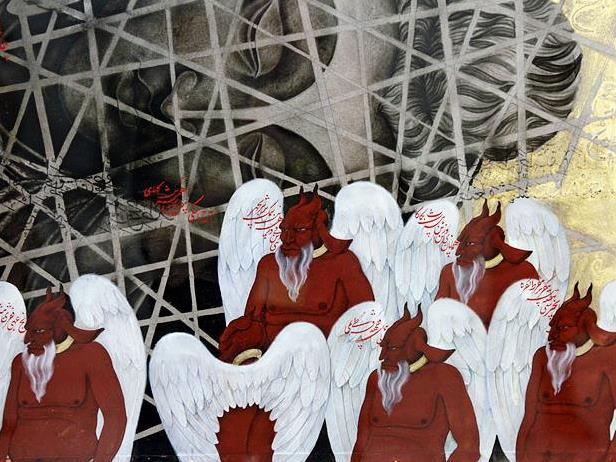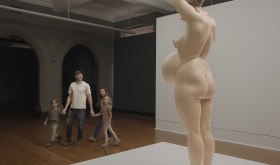Khadim Ali The haunted lotus 2013. Image via AGNSW.
While this is a modest exhibition, it is an impressive one.
Khadim Ali’s The Haunted Lotus has been scheduled to coincide with the Art Gallery of New South Wales (AGNSW) presentation of the touring blockbuster Afghanistan: Hidden Treasures, offering a contemporary voice to the story of Afghani conflict.
Khadim Ali grew up as an Afghani refugee in Pakistan where he got his training from the famous National College of Arts in Lahore, known for its miniatures, calligraphy and mural tradition. It is the anchor one recognises first in Ali’s work, the role of traditional storytelling, which then ushers the viewer through this style to consider what the contemporary story might be.
Stepping from delicate gouaches and ink paintings of demons drawn from the Shahnameh, or Book of Kings, an epic poem written around 1010 CE by Persian Firdausi blending mythology and history, Ali pumps these tales of good and evil into steroid proportions, so that at near life size the demons step outside mythology to a haunting present.
The exhibition is layered from many levels. Despite this scale shift, it attempts a conversation across medium, pulling the delicate miniatures into textiles and rug making, and including a single channel video work that sits adjunct to the other pieces.
What this video does is pull the viewer back to the contemporary moment; to reiterate what he describes as ‘cultural vandalism’ and the dehumanising of the Hazara people in Afghanistan. While I don’t think the video is an entirely successful artwork, it is an emotive sketch of time and place – a “tone setter” – that has a disorientating quality.
Is it necessary? Yes and no. The strongest element in this exhibition remains Ali’s venture into working with traditional weavers in Afghanistan. Apart from their more literal content and contemporary inflection, the richness in thread, colour and skill is stunning. There is a deeply rooted cultural tradition of carpets in Afghanistan, and their role of symbolic motifs is key, not unlike the Shahnameh, which consequently was one of only two books Ali’s family carried when they fled Afghanistan, along with the Koran.
I want to return to scale with these textiles – on one hand they contrast superbly with the delicate refinement of his miniatures, the imagery bouncing between a micro and macro consideration, and on the other we can start to understand the function of scale here as they reflect the presence of the 6th century Buddha statues from the cave of the Hazarajat region destroyed by the Taliban in 2001.
Ali’s family is from Bamiyan in the Hazarajat region. Ali said, ‘My demons are the story of my historical self and a people who are displaced and shelterless around the world.’
The gallery is painted a dark grey, the lighting is low, and the space a kind of sanctuary punctuated by jewels. It has a conversation physically with the upstairs exhibition of treasures secured from Taliban destruction, and a very personal one for Ali.
As a visitor to this space that story is palpable.
ArtsHub walks you through the exhibition.
Khadim Ali moved to Sydney four years ago. His work was included in the 2012 Documenta exhibition, and has been collected by the Guggenheim Museum in New York, the British Museum, Fukuoka Asian Art Museum in Japan, QAGOMA and the AGNSW.
Rating: 4.5 out of 5 stars
Khadim Ali: The Haunted Lotus
Art Gallery of New South Wales
Dates: 6 March – 1 June
Artist talk: Saturday 10 May, 2pm.





